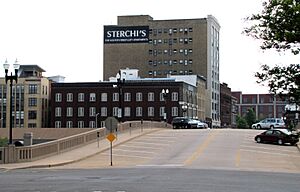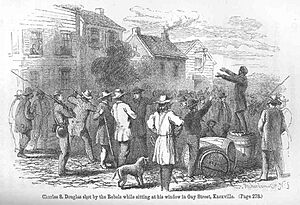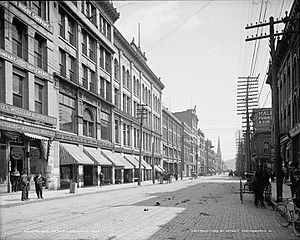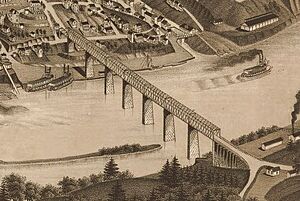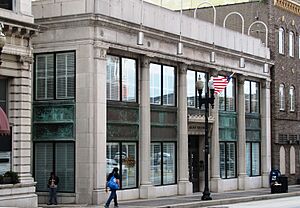Gay Street (Knoxville) facts for kids
Quick facts for kids |
|
|
Gay Street Commercial Historic District
|
|
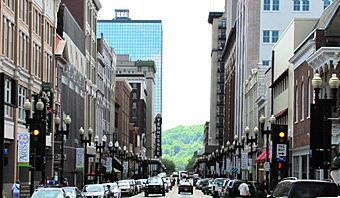
Gay Street, looking south from Wall Avenue
|
|
| Location | Roughly along Gay Street from Summit Hill Drive to Church Avenue Knoxville, Tennessee |
|---|---|
| Area | approximately 13 acres (5.3 ha) |
| Built | 1870–1938 |
| Architect | Baumann & Baumann, R. F. Graf, Cal Johnson, John Kevan Peebles; multiple |
| Architectural style | Classical Revival, Vernacular Commercial, Italianate Commercial, Art Deco, Romanesque Revival, Second Renaissance Revival |
| NRHP reference No. | 86002912 |
| Added to NRHP | November 4, 1986 |
Gay Street is a very important street in Knoxville, Tennessee. It runs right through the middle of the city's downtown area. For over 200 years, Gay Street has been a main spot for businesses and money in Knoxville. It has played a big part in the city's history and culture.
This street has some of Knoxville's tallest office buildings and oldest shops. Many buildings on Gay Street are even listed on the National Register of Historic Places, which means they are special historical places.
Gay Street was planned way back in 1791 when Knoxville was first laid out. It was a key place for early government activities for both the city and the State of Tennessee. By 1850, most of Knoxville's business happened on Gay Street. In 1854, it became the city's first paved road.
During the American Civil War, both Union and Confederate supporters held meetings on Gay Street to find new soldiers. After the war, Gay Street grew even more as railroads brought new industries to Knoxville. Famous writers like Mark Twain have even mentioned Gay Street in their books!
Many important cultural places are on Gay Street. These include the Lawson McGhee Public Library (opened 1886), the Bijou Theatre (opened 1909), the Riviera Theatre (1920), and the Tennessee Theatre (1928). Old newspapers and radio stations also used to be located here.
Contents
Exploring Gay Street: Landmarks and Locations
Gay Street stretches for about a mile and a half. It starts in the north at Emory Place and ends in the south where it meets Sevier Avenue and Blount Avenue, near the Tennessee River. The street is split into North Gay and South Gay by the Southern Railway tracks. South Gay is the older and busier part.
North Gay Street Highlights
- Emory Place Area: The northern end of Gay Street is near the Emory Place Historic District. You can find First Christian Church and St. John's Lutheran Church close by.
- Under the Interstate: A section of North Gay Street goes under Interstate 40. This space is often used for parking cars.
- Main Roads Meet: Near East Magnolia and West Depot Avenue, major roads like U.S. Route 70 and U.S. Route 11 join Gay Street for a short distance.
- The Gay Street Viaduct: This is a large bridge that crosses over the Southern Railway tracks. From the viaduct, you get a great view of the Old City and the old warehouses. The Southern Railroad Terminal is right next to the viaduct.
South Gay Street Highlights
- Historic Warehouse Area: The first block of South Gay Street (100 block) is part of a historic district with old warehouses. Here you'll find the 10-story Sterchi Lofts building and the Commerce Building.
- Commercial District Begins: The 300 block of South Gay is where the main Gay Street Commercial Historic District starts. You can see the five-story Century Building and the Knoxville Visitors Center here.
- After the "Million Dollar Fire": The 400 block of South Gay has many buildings that were rebuilt after a huge fire in 1897. Notable places include the Kress Building and the McNulty Building, which is now a Mast General Store.
- Krutch Park Side: The 500 block of South Gay is next to Krutch Park. This area has the Fidelity Building, the Riviera Theatre, and the historic Farragut Hotel building.
- Theaters and Banks: The 600 block is home to the famous Tennessee Theatre and the old Mechanics' Bank building. A sculpture called "The Oarsman" stands at the corner of Church and Gay.
- Knoxville's Tallest Building: The 800 block of South Gay has the First Tennessee Plaza, which is the tallest building in Knoxville. The Bijou Theatre, Knoxville's oldest commercial building, is also on this block.
- Government Buildings: The 900 block is home to the Riverview Tower, the Andrew Johnson Building, and the Knox County Courthouse. The City-County Building is also nearby.
- The Gay Street Bridge: This long steel bridge crosses the Tennessee River. It connects downtown Knoxville to South Knoxville.
- End of the Road: Just across the bridge, Gay Street meets Sevier and Blount avenues.
History of Gay Street
Early Days and Name Changes
Gay Street was part of the very first map of Knoxville, drawn in 1791. It first went from the river to what is now Church Avenue. Over time, it grew longer. In its early years, Gay Street had different names like "Market Street" or "Court Street." The name "Gay Street" was used by 1808, possibly inspired by a street in Baltimore.
The corner of Gay and Main was a very important spot in the late 1700s. Knoxville's first store opened here in 1792. The city's first big hotel, the Lamar House (now part of the Bijou Theatre), was built nearby in 1817. In 1796, the first meeting to write Tennessee's state constitution happened on Gay Street.
All this early activity helped Gay Street become Knoxville's main road. By 1850, three-quarters of the city's business happened here. In 1851, the sidewalks were made wider. Three years later, Gay Street was paved with cobblestones. When the railroad was finished in 1855, Gay Street was extended even further north.
Gay Street During the Civil War
Before the Civil War, important people who supported either the Union or the Confederacy gave speeches on Gay Street. Newspapers that supported each side also had their offices here. In April 1861, both Union and Confederate supporters held meetings on Gay Street at the same time to get people to join their armies. Andrew Johnson, who later became president, spoke at the Union meeting.
When Union soldiers took over Knoxville in September 1863, their general, Ambrose Burnside, set up his headquarters at a house on Gay Street. Another Union general, William P. Sanders, was hurt in a fight and later died at the Lamar House Hotel, which was being used as a hospital.
Business Growth on Gay Street
After the Civil War, many big banks opened on Gay Street. These included Mechanics' National Bank (1882) and Holston National Bank (1890). Later, Hamilton National Bank became very powerful in East Tennessee, operating out of the Holston building.
In the 1830s, James Cowan and Perez Dickinson opened a large general store on Gay Street. This store later joined with the McClung brothers to form Cowan, McClung and Company. This company became the most successful business in Tennessee after the Civil War. Their four-story headquarters, built in 1871 on the 500 block of Gay Street, was a key part of what is now the Gay Street Commercial Historic District.
Sterchi Brothers, a furniture store founded in 1888, grew to be the biggest furniture store chain in the world by 1930. They built their 10-story headquarters on South Gay Street in 1925. Many of Knoxville's major department stores, like Miller's and S. H. George's, were also on Gay Street for a long time.
Cultural Life on Gay Street
For most of the 1800s, the Lamar House Hotel on Gay Street was the top gathering place for Knoxville's wealthy people. They held fancy parties there with special foods and drinks. By the 1930s, the Farragut Hotel (built 1919) and the Andrew Johnson Hotel (built 1929) became the most popular hotels. Country music star Hank Williams spent his last night at the Andrew Johnson Hotel in 1952.
Knoxville's first major theater, Staub's Theatre, was built on Gay Street in 1872. It showed everything from operas to wrestling. The Bijou Theatre, added to the Lamar House Hotel in 1909, hosted famous acts like the Marx Brothers and Dizzy Gillespie. In 1928, the Tennessee Theatre opened and became Knoxville's main movie theater.
Knoxville's two oldest radio stations, WNOX and WROL, broadcast from Gay Street in the 1920s and 1930s. WNOX had a popular show called "Mid-Day Merry-Go-Round," which helped start the careers of singers like Roy Acuff.
Improvements to the Street
Knoxville's first permanent bridge over the Tennessee River was built at the south end of Gay Street in 1867, but it didn't last long. In 1880, a new bridge called the "Saulpaw bridge" was built. This was replaced by the current Gay Street Bridge in 1898. At the north end of Gay Street, an iron bridge was built over the railroad tracks in 1876, making it easier for people to cross. The first Gay Street Viaduct was built in 1919, and the current one was built in 2005.
In 1876, the Knoxville Streetcar Company built the city's first trolley line along Gay Street. These trolleys were first pulled by horses, but then they were made electric in 1890. The Gay Street Bridge even had trolley tracks, which helped new neighborhoods grow in South Knoxville. Trolleys were common on Gay Street until 1947, when the lines were removed.
Changes and Comeback
In the 1950s, new shopping centers opened outside the city. Gay Street, which had problems with traffic and parking, started to lose its importance as a main shopping area. Businesses moved away. To try and make downtown better, some Knoxville business people formed the Downtown Knoxville Association in 1956. They suggested adding more parking and fixing up storefronts.
During the 1970s and 1980s, Gay Street changed from a shopping area to a place for offices. New office towers were built, and old hotels were turned into office buildings. Efforts to save historic places like the Bijou Theatre helped start a group called Knox Heritage, which focuses on saving Gay Street's history. More recently, many tall buildings on Gay Street have been turned into apartments and condos.
In 2012, a national planning group called the American Planning Association named Gay Street one of its top 10 "Great Streets" in America!
Gay Street Commercial Historic District
The Gay Street Commercial Historic District was added to the National Register of Historic Places in 1986. It includes many buildings built between 1880 and 1940. These buildings range from old wholesale shops to movie theaters.
Some other important buildings on Gay Street are also listed separately on the National Register. These include the Andrew Johnson Hotel, the Bijou Theatre, and the Knox County Courthouse.
Here are some notable buildings in the Gay Street Commercial Historic District:
- Century Building (312 South Gay): A five-story building from 1898, sometimes called the Haynes-Henson Building.
- McNulty Building (402 South Gay): A four-story building from 1898, now home to a Mast General Store.
- Kress Building (417-421 South Gay): A four-story building built in 1925 in the Art Deco style.
- Woodruff Building (424 South Gay): A five-story building from 1905. It's now home to the Downtown Grill and Brewery restaurant.
- Sanford, Chamberlain and Albers Company Building (430 South Gay): A three-story building from 1870, now called Tailor Lofts with a restaurant and apartments.
- Fidelity Building (500-504 South Gay): A four-story building from 1871, which was once home to a big wholesale company.
- Riviera Theatre (510 South Gay): A two-story Art Deco theater built in 1920 and updated in 2007.
- Farragut Hotel (526-530 South Gay): A nine-story building from 1919, now a condominium with a restaurant.
- The Holston (531 South Gay): A 14-story building from 1912-1913, originally a bank, now a condominium.
- Tennessee Theatre (600 South Gay): A beautiful 12-story building from 1908. The Tennessee Theatre, added in 1928, is still a popular place for shows.
- Mechanics' Bank and Trust Company Building (612 South Gay): A five-story bank building from 1907.
- Journal Arcade (618-620 South Gay): A two-story building from 1924, originally the press room for The Knoxville Journal newspaper.
- Cal Johnson Building (311-313 State Street): A three-story building from 1898, built by a famous African-American businessman, Cal Johnson.




